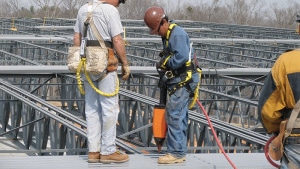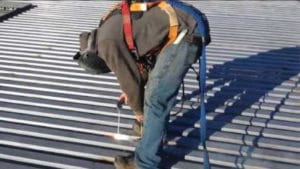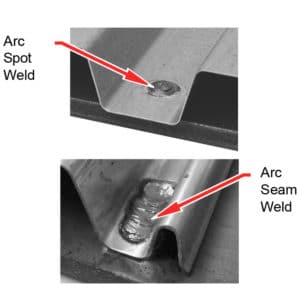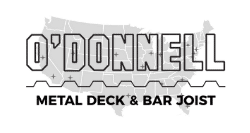Table of Contents
Fastening Metal Deck to Supporting Members
Metal floor deck or roof deck relies on proper fastening. Whether it is for wind or seismic protection, acting as a concrete form, providing bracing to joists or beams, or working as a safe platform during construction, proper fastening lets the deck do its job.
Traditionally, deck has been installed using welds for fastening to supports. However, mechanical fasteners such as screws and power actuated fasteners, recently have been common alternatives.
In order to understand exactly what is metal deck used for, you first need to understand a few basic principles of how metal deck works:

How Should I Choose a Fastening Method?
Generally, arc spot welded support connections are stronger and less flexible than mechanically fastened support connections for both shear and uplift forces, if done properly. This may allow for a less dense fastening pattern for the deck, but there are pros-and-cons to each fastening method that need to be weighed:.
- Welding is stronger but slower
- Screws and fasteners are typically faster but weaker (depending on which type is used)
Welds
Metal deck is often installed using arc spot welds, either with or without weld washers. Arc spot welds, also referred to as “puddle welds”. When metal deck is to be welded to supports the effective fusion area is at least 1/2 in. diameter for arc spot welds or at least 3/8 in. X 1 in. long for arc seam welds. Arc seam and arc spot welds are to be done as seen in the images below.
When welding, it is essential that the weld penetrates into the supporting joist or beam, and that the puddle is above the deck surface. The entire welding process usually happens within 3 to 6 seconds, but can be longer when welding thicker sheets of deck or multiple sheets at a time. This process does require a welder that is skilled enough to make these types of welds.
An great reference for additional information is the SDI White Paper, Arc-Puddle Welds and Weld Washers for Attachments in Steel Deck, which is free to download on the SDI website.


What Are Arc Spot Welds?
The arc spot or “puddle” weld is created by striking an arc on the deck surface, which creates a hole to form in the deck. The weld then deposits an electrode material on the supporting joist or beam and allows the molten “puddle” to adhere to the penetrated deck. It is important that the finished weld penetrates both the deck and the supporting member. The entire welding process should only last 3 to 6 seconds, for most cases but welding times can vary depending on different equipment and techniques used. This does require a qualified welder to make these types of welds. Arc spot welds can be made through multiple thicknesses of steel deck, as long as the thickness of the deck does not exceed 0.15 inches. Arc seam welds are required at support locations adjacent to the sidelap due to limited available weld area. The visible width of arc seam welds is to be at least 3/8" and the visible length is to be at least 1".

What are Weld Washers?
Weld washers are small steel washers that may be curved to fit into the valleys of deck panels. Washers can vary in thickness and have different hole shapes and sizes. Weld washers are placed where a weld is needed on the sheets of deck, and an arc weld is made inside the hole, until the hole is filled. The weld washer acts as a heat sink and protects the sheet from burn through in thinner sheets of deck. Welding washers are commonly used when welding sheets of deck that are higher than 22 gauge (0.0295 in.) It is essential to understand the heat issue when welding normally the washer will reduce or virtually disappear into the fusion to the substrate when welds are made through thick enough sheets of deck. Normally, weld washers are recommended for welding deck sheets that is thinner than 0.028 inches.
Screws
Screws can also be used for fastening metal deck sheets to supporting members. Typically, #12 or #14 screws are used for support fasteners. Depending on the total thickness of the steel to be connected, changes the length of the screws needed. Screws are installed using a torque controlled drill for proper installation without overdriving and stripping the screw. Several manufacturers provide “stand up” drilling equipment for easier and faster use.

Power Actuated Fasteners
Power actuated fasteners (or PAF’s) look similar to short nails that are driven into the supporting members using either powder cartridges or pneumatic pressure. The driving process allows the fastener to puncture the steel deck and fuse the fastener shank to the base steel supports. Unlike the other types of fasteners these cannot be used for side lap connections. The force used for driving the PAF varies depending upon the steel thickness and strength. Following the manufacturer’s instructions ensures proper driving by, using the correct power setting, testing and checking the fastener by making a few trial fastenings before proceeding .


How Can I Fasten Deck More Economically?
On larger structures, think about zoning your deck connection design and select the fastening pattern to match the uplift and diaphragm demand which will change across the floor or roof.
Another way to cut costs for deck installation is to provide the deck erector with options. Installers may have different preferences and should be considered. One way to do this is to provide a fastening pattern that meets the force requirements using generic screws and/or welds, and allow the deck installer to provide an alternate connection such as a power actuated fastener method that meets the stiffness and strength requirements.






